
This collection of editions of Jean-Baptiste Willart de Grécourt’s works presents a fascinating bibliographical puzzle, as the publication places are dubious. Given the history of clandestine and pirated editions of libertine literature, many of these printings may have been falsely dated or attributed to publishers in Amsterdam, Geneva, or Paris to evade censorship or lend credibility to the editions.
In a Sammelband with L’Art d’Aimer, Poëme Héroïque en Quatre Chants, 1745.
Philotanus. Poëme by M. l’Abbé de G***, Amsterdam, Chez David Mortier, 1721.
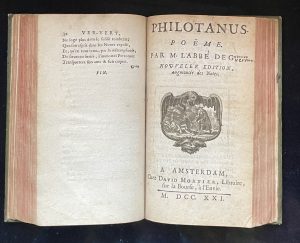
Philotanus. Poëme by M. de G***, Amsterdam, Chez Pierre Mortier, 1745.

Poésies diverses de Monsieur de Grécourt, Lausanne et Genève, 1750.
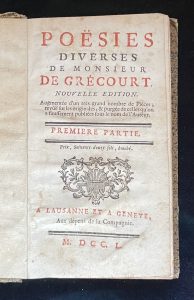
Œuvres diverses de Monsieur de Grécourt, Amsterdam, Chez Arkstée & Merkus, 1760.
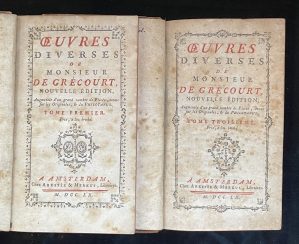
Œuvres diverses de Monsieur de Grécourt. Nouvelle édition, augmentée du Philotanus, de la Bibliothèque des Dames, &c. Avec figures. Tome Premier.
Œuvres diverses de Monsieur de Grécourt. Nouvelle édition, augmentée du Philotanus, de la Bibliothèque des Dames, &c. Avec figures. Amsterdam, Chez Arkstée & Merkus, Libraires, 1775.
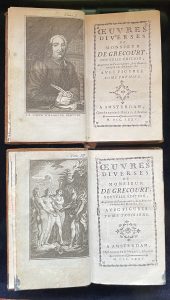
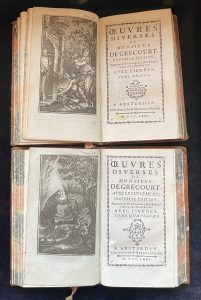
Œuvres choisies de Grécourt, Genève, 1777.
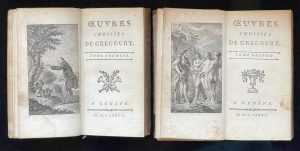
Contes érotiques et poésies choisies de Grécourt, Paris, Chez P.J.B. Nougaret, 1797.
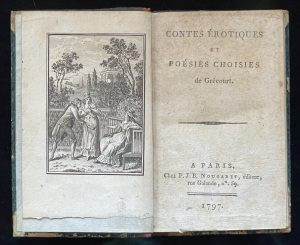
Contes et nouvelles en vers by various authors including Grécourt, Paris, A. Le Vasseur et Cie, 1894.
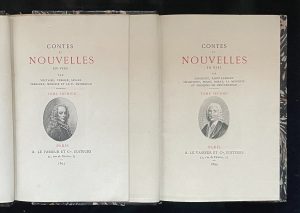
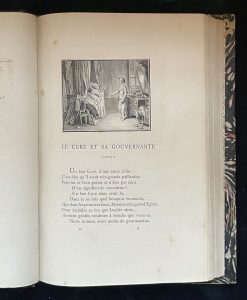
Contes galants by Grécourt, illustrated by Schem, Le Panorama des Mœurs, Éditions Vialetay, 1952.
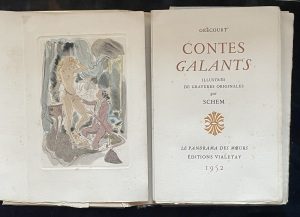
Recent acquisition (not pictured in the group shot),
Œuvres choisies de Grécourt, précédées de Considérations historiques et critiques sur le genre de Poësie auquel elles appartiennent. Paris, Paulin, Libraire-Éditeur, Place de la Bourse, 1835.
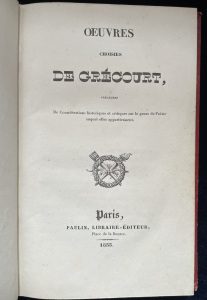
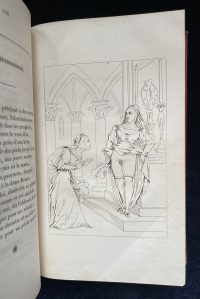
This remarkable collection of editions of the works of Jean-Baptiste Willart de Grécourt (1683–1743) spans over two centuries, reflecting the enduring interest in his satirical, erotic, and humorous poetry. Grécourt, a cleric and poet, was known for his witty and often risqué verse, which circulated widely despite frequent censorship. His works were admired for their playful language, libertine themes, and sharp critique of contemporary society.
The earliest works in this collection is Philotanus. Poëme (1721) bound together in a Sammelband with L’Art d’Aimer, Poëme Héroïque en Quatre Chants(1745), These editions showcase the poetic influences of the early 18th century, including classical themes and moralistic undertones, despite their often satirical or amorous nature.
The 1745 edition of Philotanus and Poésies diverses de Monsieur de Grécourt reflect the growing popularity of Grécourt’s verse, with increasing attention to publishing quality and accessibility.
In 1750, Poésies diverses de Monsieur de Grécourt, was published in Lausanne and Genève.
The 1760 Œuvres diverses de Monsieur de Grécourt, published in Amsterdam by Arkstée & Merkus, marks an expansion of his collected works, compiling previously scattered pieces into a comprehensive volume.
The 1775 edition of Œuvres diverses de Monsieur de Grécourt, also published in Amsterdam by Arkstée & Merkus, is a significant augmented edition. It includes Philotanus and La Bibliothèque des Dames, among other works, and features engravings that enhance the reading experience. The inclusion of illustrations suggests an effort to appeal to a broader audience, possibly those interested in the artistic and literary culture of the time.
By 1777, Œuvres choisies de Grécourt (Geneva) presents a curated selection of his best-known works, emphasizing his literary reputation.
The 1797 Paris edition, Contes érotiques et poésies choisies de Grécourt, published by P.J.B. Nougaret, highlights the persistent demand for his erotic tales, particularly in the revolutionary era, when libertine literature found renewed interest.
The 19th and 20th centuries saw continued reprints and adaptations of Grécourt’s works. The 1894 Parisian edition Contes et nouvelles en vers, which includes contributions from other authors, places Grécourt within a broader tradition of French verse storytelling. Finally, the 1952 Contes galants, illustrated by Schem and published by Éditions Vialetay, represents a modern reinterpretation, pairing Grécourt’s provocative tales with period-inspired artwork.
This collection not only traces the evolution of Grécourt’s literary reception but also reflects broader shifts in publishing, censorship, and taste in erotic and satirical literature from the early 18th century to the mid-20th century.
